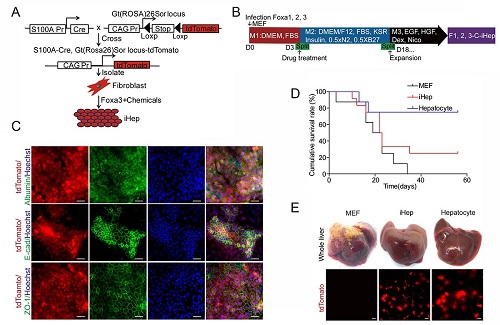Liver failure is a deadly illness and one of the most common causes of death. Liver transplantation is a well-practiced approach for the treatment of end-stage liver failure, but the applicable organ is limited due to ethical and possible immune rejection problems. Therefore, artificial liver is in great therapeutic needs.
A few years ago, Chinese scientists have reported the successful generation of induced hepatocytes from mouse and human fibroblasts with a group of transcription factors (TF). And these induced hepatocytes have been used to develop artificial extracorporeal liver support.
Prof. XIE Xin’s group from Shanghai Institute of Materia Medica (SIMM), Chinese Academy of Sciences (CAS) focuses on chemical-induced somatic cell reprogramming and transdifferentiation studies. A number of years ago, they reported that a chemical cocktail containing BrdU can generate the induced pluripotent stem cell (iPSCs) without any genetic factors. And they also found the generation of spontaneously beating cardiomyocyte-like cells from mouse fibroblasts by using only 3-6 small molecule compounds.
Recently, Prof. XIE’s group discovered that a chemical cocktail (including 6 small molecules) can promote the reprogramming of mouse fibroblast into hepatocyte-like cells (iHeps) with only one TF (Foxa1, Foxa2 or Foxa3). These iHeps show typical epithelial morphology, express multiple hepatocyte-specific genes including AFP, Albumin, E-cadherin, Hnf4α, etc., and acquire hepatocyte functions, such as albumin secretion, glycogen storage and drug metabolism.
To confirm the fibroblast origin of these iHeps, a genetic lineage tracing method (as shown in figure blow) were used. More interestingly, compare to the primary hepatocytes, which are very difficult to culture and propagate in in vitro culture, these iHeps are expandable in vitro and could maintain hepatic functions to many passages. Most importantly, these iHeps can reconstitute the damaged hepatic tissues of the fumarylacetoacetate hydrolase-deficient (Fah-/-) mice, and rescue the lives of these mice with liver failure.
This study provides a new strategy to generate functional hepatocyte-like cells by using a single TF plus a chemical cocktail, not conflicting with the current ethical and possible immune rejection problems as well as tumorigenic problem. Most importantly, “It is one step closer to generate the full-chemical iHeps” Prof. XIE said,
This work was supported by Chinese Academy of Sciences, Ministry of Science and Technology of China, and the National Natural Science Foundation of China.
Original article: http://www.sciencedirect.com/science/article/pii/S221367111730276X

Figure: Lineage tracing of Foxa3-6C-induced transdifferentiation of MEFs toward iHeps. And iHep cells rescue Fah-deficient mice and support hepatic function in vivo. (Image by SIMM)
Contact:
Prof. XIE Xin
Shanghai Institute of Materia Medica,
Chinese Academy of Sciences
Email: xxie@simm.ac.cn

